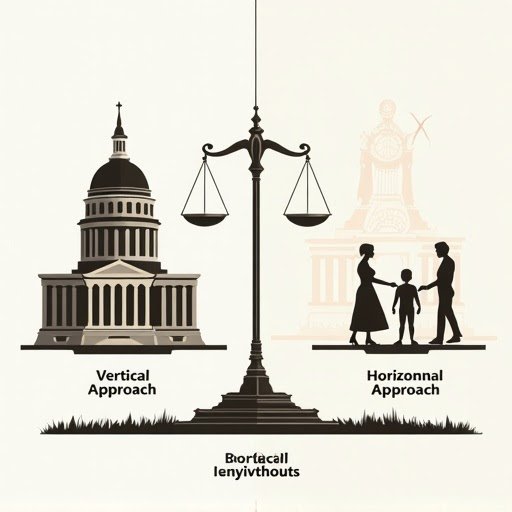[ad_1]
The distinction between the horizontal and vertical application of fundamental rights is a key concept in
constitutional law, particularly in interpreting rights under the Indian
Constitution. This distinction was discussed in the Supreme Court’s recent
decision in Vibhor Garg vs. Neha
(2025) and earlier cases such as K.S.
Puttaswamy and Kaushal Kishore.
Vertical Application of Fundamental
Rights
·
Definition: Vertical application means that the fundamental rights in
the Constitution primarily restrict the actions of the State or State actors.
·
Scope: The government and its instrumentalities are obligated to
respect fundamental rights, and individuals can seek remedies against the State
if these rights are violated.
·
Example: Article 21 (Right to Life and Personal Liberty) primarily
protects citizens against unlawful actions or intrusions by the State, e.g.,
illegal detention or state surveillance without due process.
·
Legal Basis: This understanding follows from Article 12 of the
Constitution, which defines “State” for the purpose of fundamental rights
enforcement.
Horizontal Application of Fundamental
Rights
·
Definition: Horizontal application means fundamental rights can be
enforced between private individuals
or entities, not just against the State.
·
Scope: This directs how one private party can be held to
obligations respecting another’s fundamental rights, creating duties
enforceable in civil or criminal law.
·
Example: Cases involving discrimination under Article 15 or the
right against untouchability under Article 17 have been viewed as having
horizontal effect, binding private individuals.
·
Legal Debate: The Indian Supreme Court has
cautiously engaged with horizontal application; while the idea is gaining
traction, particularly to combat discrimination and privacy violations by
private actors, the enforcement and scope differ from vertical application.
Key Differences
|
Aspect |
Vertical Application |
Horizontal Application |
|
Who is |
The State (government and its agencies) |
Private parties (individuals, companies, etc.) |
|
Who |
Courts enforce fundamental rights against the State |
Courts and civil law mechanisms enforce between private |
|
Scope |
Constitutional remedies like writ petitions against State |
Civil damages, injunctions, or criminal penalties |
|
Examples |
Challenging unlawful State detention or surveillance |
Enforcing privacy rights between neighbors, |
|
Constitutional |
Article 12 and constitutional text focus on State actions |
Derived progressively by jurisprudence, not explicit in |
The Indian Context
·
The
Supreme Court in K.S. Puttaswamy
(2017) affirmed that State action
infringes fundamental rights directly, but acknowledged the growing need to
control private violations of privacy (“horizontal effect”).
·
The Kaushal Kishore case (2023) further
elaborated that some fundamental rights, including privacy, can be enforced
horizontally, but enforcement remains distinct as compared to actions against
the State.
·
The
distinction matters in matrimonial disputes (e.g., in Vibhor Garg vs. Neha), as the Court held that while spouses have
protected confidential communication (under Section 122 Indian Evidence Act),
this privilege does not extend horizontally to shield privacy claims from
evidence admissibility in court proceedings.
Summary
·
Vertical application restricts State
actions against citizens’ fundamental
rights and governs public law.
·
Horizontal application governs
relations between private parties and imposes duties to respect rights during their private
interactions.
·
The
distinction is fundamental to understanding how and against whom fundamental
rights can be enforced, with constitutional rights focusing primarily on State
action but gradually recognizing obligations among private persons for certain
fundamental rights like privacy and equality.
This explanation encapsulates the
evolving constitutional jurisprudence on horizontal and vertical application of
fundamental rights in India, highlighting its significance in balancing
individual rights with societal and legal frameworks.
[ad_2]
Source link


.png)